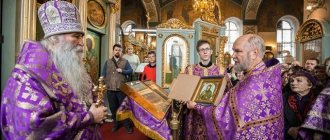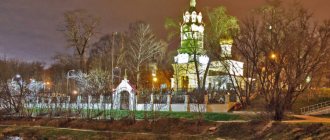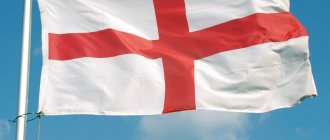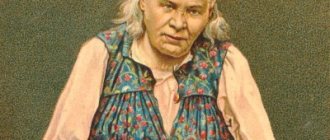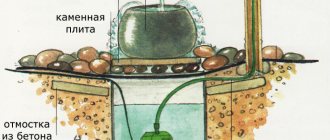Paraskeva of Iconium (Friday), great martyr of the 17th century. wood, gesso, tempera Orenburg Regional Museum of Fine Arts
Holy springs are an invaluable support for Orthodox believers. Since ancient times, they have been perceived as a divine gift in all Orthodox countries, including Rus'. The veneration of water is considered a special tradition, which began with the Baptism of Jesus Christ, when He entered the waters of the Jordan River. After this, the water began to have special properties.
Sources of Paraskeva Pyatnitsa in Russia
That is why hundreds of miraculous springs and springs are located in the vastness of our homeland. The stories of their origin are very similar - icons were found on some, ascetics were revealed to others, some sources were prayed for by the saints of God during their lifetime. Therefore, most sources are named after them. In almost every region of Russia there is a source of the Holy Great Martyr Paraskeva.
Holy springs in the Ryazan region
Salaur
In the Ryazan region, in the Shilovsky district, there is one of these shrines, along with a font, not far from the village of Salaur.
Useful materials
There is a legend that one local resident saw an extraordinary glow in the forest. Taking a closer look, he saw an icon depicting a beautiful girl - it was Paraskeva Pyatnitsa. He took the image to the local temple, but in the morning the icon disappeared from the temple. She was found in the same place, in the forest. So he walked with the icon from the forest to the temple several times, until at the place of its appearance he hammered a key. And only then did he realize that this was a sign from God and built a chapel together with other peasants. The revealed icon was also placed there.
Koshibeevo
Another Ryazan Paraskevin spring is located in the village. Koshibeevo, Sasovo district. It is considered the main iconic place of the village; it is also called “Ninth Friday”. This natural stream of crystal clear water was discovered back in the 18th century. The icon of the martyr Paraskeva Friday was also seen here. Near the spring there is a bathhouse and a wooden chapel with a bell and an icon of Paraskeva. It is believed that silver particles are dissolved in water, which enhance the beneficial effect on the body.
Staroderevyankovskaya
The Krasnodar region is also famous for its healing water from the Paraskeva spring. It arose in the Kanevsky district of the village of Staroderevyankovskaya. There is an opinion that villagers once found a small icon of the Great Martyr in the water and naturally named the spring in her honor. Now it is difficult to find out when this happened, but it is known that since the twentieth century, residents have resorted to its healing water for help.
Staraya Ladoga
Perhaps the most ancient source of the Great Martyr Paraskeva is located in the Leningrad region, in the village. Old Ladoga. It has served as a place of veneration since the 9th century, as evidenced by the special writing of the Varangian cross on the stones. The spring is well equipped, with places for drinking and swimming.
Elshanka
Near the village of Elshanka, Saratov region, the “White Key” is well known - a spring blessed by Paraskeva herself. In the old days, one of the residents noticed an icon of the Great Martyr near a spring, and subsequently they built a small chapel there. During the revolutionary years, the chapel was destroyed, and the spring was abandoned. Now there is a log font and a chapel of Paraskeva. Numerous pilgrims widely use consecrated water for drinking needs. It can also be bought in stores.
Sweatshirt
But this is not the only source of Paraskeva in the Saratov region. Holy spring in the village. The sweatshirt of the Bazarno-Karabulak district has been known since the 19th century. Somewhere in the middle of the century, cattle breeders came across the icon of the Great Martyr Paraskeva near a stream and took it to the temple. But the icon itself miraculously returned from the church to the place where it was found. And then the shepherds realized that they needed to build a chapel at the source and place an icon there. The source is convenient for those who want to get water and take a dip.
Erino
This is not the first year that a spring consecrated in honor of Paraskeva Pyatnitsa in the village of Erino, Podolsk district, Moscow region, has been welcoming pilgrims. Not far from the Znamensky Church of the Blessed Virgin Mary, among the centuries-old pine trees, there is a chapel and Paraskeva font, a table and a bridge. According to the stories of an old-timer, the icon of Paraskeva Friday disappeared from a village church. After a while, she was found in the forest thicket attached to a tree. She was returned to the church again, but again she disappeared. One day, the abbot of the temple dreamed of Paraskeva and ordered her image to be taken back to the forest and the spring to be improved under the tree.
Penza region
Perhaps Saint Paraskeva is especially revered in the Penza region. Here, almost every village has its own Paraskeva.
One of the sources is located in the village of Solovtsovka. Local residents simply call it “Holy Spring”. In the 19th century, a chapel was built on the site of the appearance of the image, but in the 30s it was destroyed. It was possible to restore it only in 1996. It was re-consecrated and bathing facilities were installed.
In the city of Kuznetsk there is also a temple-chapel in honor of Paraskeva. At the beginning of the twentieth century, a wooden church was built with money from donors; inside there was an icon of the great martyr. The church was destroyed in the 70s. Now a new temple and bathhouse stand on this site.
Kamensky district in the village. Kevdo-Melsitovo also has a source of Paraskeva Pyatnitsa, called Kholenovsky. Orthodox Christians come to the source regardless of the weather, day of the week or time of year. On holidays, many people from all over the area gather here, although getting to the Kholenovsky spring is not very easy.
There is also Paraskeva’s spring in the Nikolsky district of the village of Serman. At the beginning of the 18th century. She appeared in a dream to a blind poor man and ordered him to go down from the mountain and pick up her face from the water. As soon as the peasant approached the stream and drops splashed onto his eyes, he was immediately healed. Happy, he took the icon to the nearest temple, and a small chapel was built at the source. In the 20th century everything was destroyed. Now the holy place has been improved thanks to residents and pilgrims.
In addition, in the Penza region, the spring of St. Paraskeva in the Moksha region is famous. Bogorodskoe. People called it “Ninth Friday”. This is due to the miraculous healing of a pious man on the ninth Friday of Easter. It happened through the appearance of the Great Martyr to him in a dream. An oak well was built with love and reverence, and a wooden cross with prayer was erected.
In Russia, the holy martyr Paraskeva Pyatnitsa is historically more revered.
But besides her, the holy venerable martyr Paraskeva of Rome is also widely known and loved. She lived in the 2nd century AD. and suffered for her faith from the pagans, accepting martyrdom.
Northern summer resident - News, Catalog, Consultations
According to one version, the name of the village of Syabero and Lake Syabero comes from the name of the free Pskov-Novgorod landowners - Syabrs. This is the name given to shareholders, co-owners of arable land and fishing grounds,
not only peasants, but also landowners and even clergy, who, owning their shares (lots) in common lands - lands, could freely dispose of them, enter into land transactions, etc. (Syab - in Slavic equal, common, friendly) By the end of the 16th century, Syabrinism disappeared. However, in reality this version does not stand up to criticism: there is not enough arable land around Syabero - more and more sand, forests and swamps. It is more likely that by general, artel they could have meant fishing on the lake (L. Uspensky’s version). Another version of “friendliness” and “brotherhood” (from the Slavic syaber (neighbor, brother, friend)) (version by M. Vasmer) is meant to be understood in the sense of brotherhood of the two halves of the lake, separated by capes. The butterfly shape of the lake may have been reflected in its name. According to Sami researcher Kondratyev, the name Syabero has Sami roots, since in Sami, Syabero is a butterfly.
The village itself was originally called Podledye and only towards the end of the 19th century was renamed the village of Syabero. In the old days, the village did not stand on a cape, but on an island called Sokolya Gorka. The first settlements on the shores of Lake Syaberskoye appeared in the primitive era. According to information collected by local teacher V.Ya. Efimov, there were Krivichi settlements on the shores of Lake Syaberskoe. According to the list of Identified Cultural Heritage Objects located on the territory of the Leningrad Region, there are several groups of burial mounds near Syabero (to the south and north of the village), and next to the Zvanka stream there is an ancient settlement and parking lot.
In Syabero there was an ancient water route along the rivers Luga-Verduga-Plyussa-Lyuta-Zhelcha, connecting Novgorod with the southern part of Lake Peipsi. In the old days there was a portage (kopanka) for ships traveling along the Verduga River from the river basin. Plyussy (from the village of Voloshnya on the Zhelche River, a tributary of the Plyussa) to the Saba River from the Luga River basin. One of the main overland trade routes from Novgorod to the west to Yuryev (Dorpt), skirting Pskov from the north, also passed near Syabero. The “Historical and Statistical Description of the St. Petersburg Hierarchy” says: “Two miles from the churchyard there is a road that begins near Luga from the former Smolenskaya, and after the Warsaw road, goes west along Gdov through Luga and Gdov districts. The road is now abandoned and is considered the road of the Lithuanians and the military route of the troops of Peter the Great.”
The book “Historical and statistical description of the St. Petersburg diocese” says: “The Syaber churchyard, or the abolished Syabersky monastery, is located 200 versts from St. Petersburg and 60 versts from Luga, on an island of Lake Syabersky, connected to the village by a dam. According to legend and clergy records, the church has existed here since 1670. The current wooden church, in the name of the Savior Not Made by Hands, was built in 1853. Completion of the church with a bell tower cost 3,618 rubles. ser. The antimension was consecrated by Metropolitan. Job, under Patriarch Adrian, in 1690. From the inscription on the cross, under the altar, it is clear that the temple was consecrated in 1853, January 29, by Luga Archpriest Andrei Filippovich Laskin, under the priest Mikhail Ilyinsky. The temple was built by carpenter Ivan Petrov.
In the temple, worthy of attention: 1) the ancient icon of the Savior Not Made by Hands, above the royal doors, painted on wood, on a gold background, decorated, in 1867, with a silver robe, worth up to 550 rubles; 2) tin sacred vessels 3) tin tabernacle, weighing 3 pounds; 4) service book, printed in Moscow on August 1655, 31 days. In 1867, with money collected from books, a new iconostasis was built, costing about 1,630 rubles.
According to the staff of 1842, the clergy of the temple in Syabero consists of a priest, a sexton and a sexton. Among the former priests, the following are known: Antip Sergeev, Nikita Antonov, Stefan Zakharov (d. 1838), Feodor Opolsky, Alexander Svetlov (d. 1850), Nikolai Tripolsky, expelled for staff in 1852, Mikhail Ilyinsky (d. . in 1855), Peter Alandsky (died in 1858), Alexander Leokhnovsky, paralyzed; in 1860, a supernumerary priest, Nikolai Tripolsky, served in his place. Nowadays Pyotr Bogdanov serves. Before the states, the clergy was supported by income from services and land. Rugs were collected, from a married parishioner, a quadrangle of rye. The salary was 300 rubles. Ass. in year. Moreover, the clergyman owned the “Ogubko” of Lake Syaberskoe. According to the state in 1843, the salary of a clergyman was 310 rubles. Nowadays a priest receives 200 rubles, and a psalm-reader receives 70 rubles. In addition, the clergyman receives 15 rubles. percent from three hundred-ruble tickets.
Church land 340 dessiatinas. 1.366 fathoms. Of these, 18 dessiatines are arable, 5 dessiatines are haymaking, and 317 dessiatines are forest. 1,366 soot. The clergyman uses this land only for mowing, and rents out the rest to the peasants.
The church house was built by priest Alexei Ivanov, and in 1872 it was purchased as church property for 930 rubles. The parish consists of the following villages: Lyadinki, Dubrovitsy, Zasobie, Podledya, Verduga, Zaverduzhye, Zatrubichye, Smorodina, Ivanovka, Zhitkovitsy, Kozlovo, Pustoe Gorneshno, Zhiloe Gorneshno, Pazhino, Sabitsy, Eleshno and Klyuchki.
Parishioners by clergy. Gazette 1883 husband. gender 703, female 811.
There are lakes in the parish: Syabera, Verduga, Gorneshnya, Plovucheya, Chernaya, etc. Rivers: Saba, Chernaya, Lodiya, Zvanka and Lyubivka. Up to 25 literate people. From 1847 to 1854 there was a school in Podledye, opened by the Oranienbaum palace board. Up to 30 children of both sexes studied there; the house for the school was rented from a peasant, with a fee of 40 rubles. ser. with heating. In 1862, a school was opened in the same village, and sexton Pyotr Utkin began teaching there. In 1882, a zemstvo school was opened in Syaber. In 1883, there were 14 boys and 5 girls studying there. There is also a private school in Sabice, in the 12th century. from the church.
Rural holidays in Syabero are as follows: 1) on Elijah Friday, a religious procession from the church to the chapel in the name of Paraskeva, located 5 versts, near the village of Verdugi. In the chapel, under the floor, there is some kind of collapsed stone, and near it there is a key on which the blessing of water takes place on this day; 2) To the Savior Not Made by Hands - in Syaber; 3) Trinity - in Zatrubichye and Gorneshny; 4) Pokrova in Sabice; 5) Nicholas the Wonderworker and Flora and Laurus - in Dubrovitsy: 6) George in Eleshna, Smorodino and Lyadinki; 7) St. Nicholas in Verdug and Zaverduzhye; Nativity of the Virgin Mary and St. Great Martyr Demetrius in Zhitkovitsy and Ivanovka; 9) to the Cathedral of John the Baptist on January 7 - in Pazhin and Klyuchki. There are four chapels: in the name of St. Nicholas the Wonderworker - in Sabitsy and Zaverduzhye. Pokrova - in Zhiliy Gorneshnya and Paraskeva near the village of Verduga. The trusteeship was opened in 1875. Its funds are insignificant. So eg. in 1883, 2 rubles were collected from various individuals. 40 kopecks, and 55 kopecks in a mug.
In the chapel, under the floor, there is some kind of collapsed stone, and near it there is a key on which the blessing of water takes place on this day; 2) To the Savior Not Made by Hands - in Syaber; 3) Trinity - in Zatrubichye and Gorneshny; 4) Pokrova in Sabice; 5) Nicholas the Wonderworker and Flora and Laurus - in Dubrovitsy: 6) George in Eleshna, Smorodino and Lyadinki; 7) St. Nicholas in Verdug and Zaverduzhye; Nativity of the Virgin Mary and St. Great Martyr Demetrius in Zhitkovitsy and Ivanovka; 9) to the Cathedral of John the Baptist on January 7 - in Pazhin and Klyuchki. There are four chapels: in the name of St. Nicholas the Wonderworker - in Sabitsy and Zaverduzhye. Pokrova - in Zhiliy Gorneshnya and Paraskeva near the village of Verduga. The trusteeship was opened in 1875. Its funds are insignificant. So eg. in 1883, 2 rubles were collected from various individuals. 40 kopecks, and 55 kopecks in a mug.
In the old days, the local residents of Syabero made a living by preparing Koporye tea: Koporye tea is prepared from the leaves of lungwort and fireweed, the processing of tea (boiling it, grinding it with soil, drying and sifting) is done in late autumn and spring. In earlier times, it was bought by small buyers for resale to city tea traders, as well as for shipping abroad. The color of the Koporye tea infusion is no different from Chinese tea, but its taste is reminiscent of bad Chinese tea.” Other sources of income were sawing and hauling firewood and fishing.
The village of Syabero is located southwest of the city of Luga, 17 km from the volost center of Voloshovo, on the shore of the lake of the same name, on a cape, along the road Luga - Voloshovo - Bolshiye Sabitsy. The village (or rather the village) of Syabero is quite well maintained. There is a working store in the village. The population of Syabero is mainly pensioners and summer residents.
The first settlements on the shores of Lake Syaberskoye appeared in the primitive era. Near the village of Syabero, two sites of Neolithic man with a characteristic type of clay products (pit-comb ceramics) were discovered. A settlement was also discovered here, dating back to ancient Russian settlements of the 15th – 16th centuries. There are also burial mounds on the shore of the lake.
The village of Syabero arose on a spit formed from four islands, inhabited by the families of four settlers who “jointly cultivated the land and owned livestock,” i.e. were co-owners - brothers. This is where the name of the lake comes from. The village itself was originally called Podledye and only towards the end of the 19th century was renamed the village of Syabero. The location of the village is almost unique, on a narrow strip of land stretching far into the lake.
If you are interested in purchasing a plot in Syabero and the surrounding area, by the lake, call from 11-00 to 20-00
For sale by owner.
The beauty and open spaces in Syabero are breathtaking. There is good fishing in the lake. On Lake Syaberskoye there is an experimental base of GosNIORH, where work is carried out on the breeding and commercial cultivation of carp, peled and other species of fish. The lake is inhabited by bream, pike, roach, perch, and bleak. The area of the lake is 14 square kilometers. People have long called these places “Leningrad Switzerland” or “Luga Pearl”.
At the northern end of the village, on an island separated from the main bank by a narrow channel, there is a graveyard on which the Spassky Syabersky Monastery was once founded. According to legend, the icon of the Savior, the Image Not Made by Hands, appeared to local fishermen in the waters of the lake, which was reported to the ruler of Novgorod, with whose blessing the monastery was erected.
It is believed that the monastery occupied two northern islets. On the third, behind them, there were cells; by the end of the 16th century their number had increased to seven. The village occupied the fourth, largest island. A dramatic event in the life of the monastery occurred in 1581, when it was completely destroyed by “Lithuanian people”
Wooden Church in the Name of the Savior Not Made by Hands
The first church on this site was built in the 14th century and then rebuilt in 1670. It became a parish church in 1764 after the closure of the Spassky Syabersky Monastery: the Spassky Pogost was formed in its place. The parish consisted of the following villages: Lyadinki, Dubrovitsy, Zasobie, Podledya, Verduga, Zaverduzhye, Zatrubichye, Smorodina, Ivanovka, Zhitkovitsy, Kozlovo, Pustoe Gorneshno, Zhiloe Gorneshno, Pazhino, Sabitsy, Yelemno and Klyuchki.
The development of the church project belongs to the architect Pyotr Lukashevich - based on the exemplary designs of the professor, architect K.A. Tones. The name of the builder of the temple is known: carpenter Ivan Petrov. The inscription on the cross above the throne stated that the temple was consecrated on January 29, 1853 (February 10 according to the new style).
The church built in 1850 - 1853 has survived to this day. The church was active until the priest was arrested in 1937. In 1939, icons were burned, church utensils were looted and destroyed, and a club was opened in the church. This did not last long, and then the temple stood in desolation. They wanted to adapt the church into a warehouse, but it was saved by the lack of convenient access for cars. In 1943, after the Germans left, local residents visited the church, brought icons saved from the huts after the pre-war devastation, lit lamps and candles, and prayer began to flow. In 1945, after the victory over the Germans, the temple was closed again. Restoration of the church began after the fall of Soviet power in 1991. It was returned to the parish only in 1995.
Iconostasis of the church in Syabero
Icon of St. martyr Paraskeva Fridays. New letter icon. Face of St. martyr Paraskeva is distinguished by its rare beauty. They pray to her for the preservation of pets, she heals serious mental and physical illnesses, especially fever or toothache, and helps in cases of devilish obsession. She protects family well-being and happiness, patronizes trade (hence the Friday fairs known in former times), and is considered the patroness of water: her image often miraculously appeared on a river or in a well, as a result of which the water acquired healing powers. The memory of the Great Martyr Paraskeva Friday is celebrated on October 28 according to the old style, November 10 according to the new style.
There is also a cozy refectory in the Syabery monastery. The plans of the keeper of the monastery - monk Varlaam and the construction of a hospice house. If you can and want to help, contact him about this.
Address for letters: 188281 Syabero village, Luga district, Leningrad region. Monk Varlaam (Vladimir Vladimirovich Kostroma ).
In 2000, for the first time, a procession of the cross was held again on Elijah Friday (7th Friday from Easter - before the day of the prophet Elijah) from the Syaber church to the holy spring.
You can go to Syabero either through Luga-Retyun-Serebryanka-Volosovo on an asphalt road and a decent dirt road, or through Volosovo-Osmino-Sara-Log. The turn to Syabero is located behind the village of Sara Log (behind the cell phone tower). At first, the road for about 100 meters was destroyed by timber trucks, but it was passable. Further than halfway, the road is slightly paved, and after Bolshie Sabitsa it becomes quite decent (for a dirt Russian forest road of the 21st century, 200 km from the cultural capital).
You need to turn to the holy spring of Paraskeva Friday at the worship cross. The road is a relic of an ancient portage between the lakes. Between lakes Syaberskoye and Muzh, a ridge stretches from west to east. Syaberskoye approaches this ridge as a bay that turns into a hollow. At Muzh's, the ridge is the highest, but near the lake itself it is dug artificially. Two shafts along the edges of the trench are clearly visible - earth emissions. These are clear drag marks. In ancient times, Lake Muzh was part of Verduga.
The Syabersky reserve was organized in 1976. The area is 11,400 hectares, of which the lake water area is about 2,000 hectares. Purpose of creation: preservation of the kama landscape, lake-river network, lowland swamps, rare plant species, habitats of large animals. Syabero is home to: shrew, water vole, muskrat, beaver, badger, raccoon dog, fox, wolf, brown bear, European mink, pine marten, polecat, ermine, wild boar and elk.
If you are interested in purchasing a plot in Syabero and the surrounding area, by the lake, call from 11-00 to 22-00
For sale by owner.
In these places, such rare species of birds as the great bittern, black and white storks, osprey, white-tailed eagle, black kite, lesser spotted eagle, marsh harrier, coot, moorhen, and corncrake have been recorded. Whooper swans and large mergansers stop at Lake Syabero. Orchids grow in marshes and swamps here. The lakes are popular holiday destinations.
In pre-Christian Rus', Mother Paraskeva Pyatnitsa was revered as a goddess born from a spring. She patronized women: in marriage, childbirth, housekeeping, mainly spinning and weaving. They sacrificed canvases, threads, linen tows, and sheep's wool to her. All this was thrown into the well, above which stood a wooden sculpture of Friday. This ritual was called mokrida. It was impossible to work on Paraskeva Friday. To this day they say about those who like to celebrate (not work): “He has seven Fridays a week.”
Paraskeva Pyatnitsa suffered martyrdom under Emperor Diocletian. Paraskeva Pyatnitsa's parents especially honored Friday, the day of the suffering of Jesus Christ. And that’s why they named their daughter Paraskeva, which translated from Greek means “Friday.” More precisely, the term means “preparation” (in this case, preparation for the Passover sacrifice). Friday preparation has become the name of the day of the week among Christians.
A small wooden chapel was built on the holy site by a local villager after a large wooden chapel was burned down by possessed communists in July 1959. On Ilyinsky Friday, local residents, fearing persecution from their superiors, came early in the morning, while it was still dark, in order to be on time for work without suspicion. Now the pious organizer of the chapel has already rested in Bose, and the creation of his soul and hands lives on.
The revered stone “Friday - Mother” has been located in this place near the ancient trading area on the portage since time immemorial. The trace of “Mother Paraskeva herself” is forever imprinted on the stone.
Popular legend says that when Prince Alexander Nevsky stopped for a rest at the source of the holy great martyr Paraskeva, she appeared to him, leaving a mark on the stone and predicted victory. According to his vow, the prince, on his way back after the Battle of the Ice, erected a chapel here in the name of the Holy Great Martyr Paraskeva Pyatnitsa. It is also known that on the way back, Alexander Nevsky treated his feet on a stone.
The road to the holy spring of Paraskeva Pyatnitsa. From Lake Syabero there once was a road to the village of Voloshovo. This road was partially lined with logs, in some places these logs were laid as a flooring, up to nine logs one on top of the other. In some places, the remains of logs (flooring in one layer) are still preserved.
Blessing of water at the holy spring of St. martyr Paraskeva Pyatnitsa August 2, 2013. Photo by Andrey Nikitin.
The water in the holy spring is very tasty - slightly sweet.
Information from the “Northern Summer Resident”: In 2014, noticeable changes took place at the holy spring of Paraskeva Pyatnitsa. Firstly, the construction of a hospice house - a hotel for pilgrims - is nearing completion. A new Chapel of Paraskeva Friday was built. Also, the source itself acquired a new covered font-house, for greater convenience for wanderers performing ablutions.
Here are a few photographs sent to us by a local resident (formerly a Leningrader and St. Petersburg resident) Vladimir Nikolaevich, who fell in love with these blessed places and was cured of serious illnesses here.
Chapel of Paraskeva Pyatnitsa
Approach to the font
Font outside
Font inside
Map of the Syabersky nature reserve (27 lakes and 7 rivers with spring water in pine forests), hand-drawn
Link to map of Leningrad region
Lake Syabero
If you are interested in purchasing a plot in Syabero and the surrounding area, by the lake, call from 11-00 to 22-00
Selling from the owner. There are also houses for sale.
Email mail This e-mail address is being protected from spambots. You need JavaScript enabled to view it
The village of Syabero and the surrounding area from a bird's eye view
Source of Paraskeva Rimskaya in Crimea
Paraskeva Rimskaya enjoys exceptional veneration in Crimea. There, in the women's Trinity-Paraskevievsky Toplovsky Monastery, there is a source. It was here that the saint endured her last torment. In the place where the blood of the venerable martyr was shed, a healing spring arose. As a sign of proof of this, the image of the Venerable Martyr Paraskeva was miraculously revealed at the source. In the icon she holds a bowl with eyes in her hands. It is known from life that her tormentor went blind when he tortured Paraskeva, and asked her to restore his sight. She fulfilled his request and he believed in Christ. The spring was improved in 1882. In 1864, the Trinity-Paraskevievsky Toplovsky Monastery was founded at the source. Now, next to the source of the Holy Martyr, there is a closed font. You can plunge into it both in winter and summer.
Corfu
Paraskeva of Rome is also revered in Corfu. There are several monasteries and about 50 churches built in her honor. There is also a source. It is located in Benitses. It is believed that it has the cleanest water in Corfu. Nearby there is a compact bell tower and a cozy small church in the name of St. Paraskeva.
The water of any consecrated source undoubtedly heals any ailments and sorrows. Every believer has the opportunity to visit these priceless pearls, including the springs of the Holy Great Martyr Paraskeva. After all, in almost all regions of Russia there is a source in her honor.
History[edit]
The holy spring is located on the outskirts of the village of Maryinka. In this place, near the steep, low right bank of a tributary stream of the Nerskaya River, under a tall pine forest, there are actively visited consecrated weak springs: the first (1) - in a plank well with a wooden lid near a small ravine; 20 m from it the second (2) is in a plank well with a lid made of galvanized sheet; the third (3) - in an old open plank well, 7 m from the second; fourth (4) - 7 m from the third, in a hole in the ground (a weak spring comes out of the sandy soil); the fifth (5) - in an old plank well with a galvanized lid, 5 m from the fourth. The first three springs have icons on the trees, the second spring is consecrated in the name of Paraskeva Pyatnitsa.
Life and miracles of Paraskeva Pyatnitsa
She lived in the 3rd century. in the city of Iconium. Paraskeva's parents were very rich, but at the same time very pious. They especially honored Friday, the day Jesus was crucified. In memory of this event, their daughter was named Friday. They left the girl an orphan early, but managed to instill in her strict Christian traditions and the true faith.
Paraskeva of Iconium (Friday), great martyr of the 19th century. wood, tempera Kostroma State Historical, Architectural and Art Museum-Reserve
Paraskeva took a vow of chastity and spent all her time caring for the disadvantaged, preaching the Gospel. One day, the emperor’s assistant came to the city to exterminate the Christians. Paraskeva was immediately captured and tortured. For a long time they tried to force her to sacrifice to pagan idols and renounce her faith, but each time the Lord strengthened her, sending His holy angels to help Paraskeva.
Many, seeing the miracles of salvation, believed in Christ, but the tormentors were not brought to their senses, and Paraskeva was executed by cutting off her head. With her ascetic feat, having accepted martyrdom, she once again confirmed the incommensurable all-encompassing mercy and love of the Lord.
The saint imparted special miraculous power to water, appearing in rivers and wells, and healed many diseases.
How to get there[edit]
By public transport
from Vinogradovo station, in the Ryazan direction, by bus No. 34 to the village of Maryinka, located 6.5 km northeast of Vinogradovo station. The village stretches along and the bus makes several stops in it; to get directly to the source you need the first stop. From the stop we walk back 400 m, the road makes a smooth left turn, crosses a lowland with a stream and rises up. 50 m from the stream, a dirt road goes to the right into the forest, which after 200 m leads to a turning point.
By personal transport
You can follow the Novoryazanskoe highway up to 73 km, then turn left along the Malaya Moskovskaya Ring Road, before reaching 100 meters of the railway to the right through Beloozersky and Vinogradovo to the village of Gubino. Or along the Yegoryevskoe highway to 73 km further through the village named after Tsyurupa to the village of Maryinka, passing through which, then 50 m from the stream, to the right into the forest, there is a dirt road, which after 200 m leads to a turning point at the source.
Address:
Moscow region, Voskresensky district, Marinka village
Prayers to Paraskeva Friday
Troparion, tone 4:
The all-wise and all-praised martyr of Christ Paraskeva, having accepted male strength and rejected female weakness, defeated the devil and put to shame the tormentor, crying out and saying: Come, cut off my body with a sword and burn it with fire, for I come to Christ rejoicing. , To my groom.
Through your prayers, O Christ God, save our souls. Kontakion, voice 3:
Having brought the all-holy and immaculate torment, like a most honorable wine, to the immortal Bridegroom Christ, you rejoiced the angelic countenance and conquered the demonic intrigues: for this reason we honestly honor you with faith, martyr Paraskeva, long-suffering.
Prayer
Oh, holy and blessed martyr of Christ Paraskeva, maiden beauty, praise of the martyrs, purity of image, magnanimous mirrors, wonder of the wise, guardian of the Christian faith, idolatry flattery to the accuser, champion of the Divine Gospel, zealot of the Lord’s commandments, worthy to come to the haven of eternal rest and in the devil Your bridegroom, Christ God, brightly rejoicing, adorned with the supreme crown of virginity and martyrdom! We pray to you, holy martyr, to be sorrowful for us to Christ God, whose most blessed sight will always rejoice. Pray to the All-Merciful One, Who opened the eyes of the blind with His word, that He may deliver us from the illness of our hair, both physical and mental; with your holy prayers, kindle the dark darkness that has come from our sins, ask the Father of Light for the light of grace for our souls and bodies; Enlighten us, darkened by sins, with the light of God’s grace, so that for the sake of your holy prayers sweet vision will be given to the dishonest. Oh, great servant of God!
O most courageous maiden! Oh, strong martyr Saint Paraskeva! With your holy prayers, be a helper to us sinners, intercede and pray for the damned and extremely negligent sinners, hasten to help us, for we are extremely weak. Pray to the Lord, pure maiden, pray to the Merciful, holy martyr, pray to your Bridegroom, immaculate bride of Christ, so that by your prayers, having escaped the darkness of sin, in the light of the true faith and divine deeds we will enter into the eternal light of the never-evening day, into the city of everlasting joy, in now you shine brightly with glory and endless joy, glorifying and singing with all the heavenly powers the Trisagion of the One Divinity, the Father and the Son and the Holy Spirit, now and ever and unto ages of ages. Amen.
